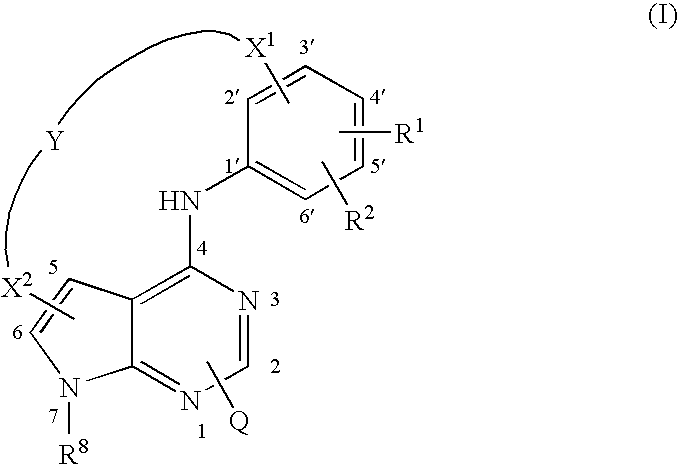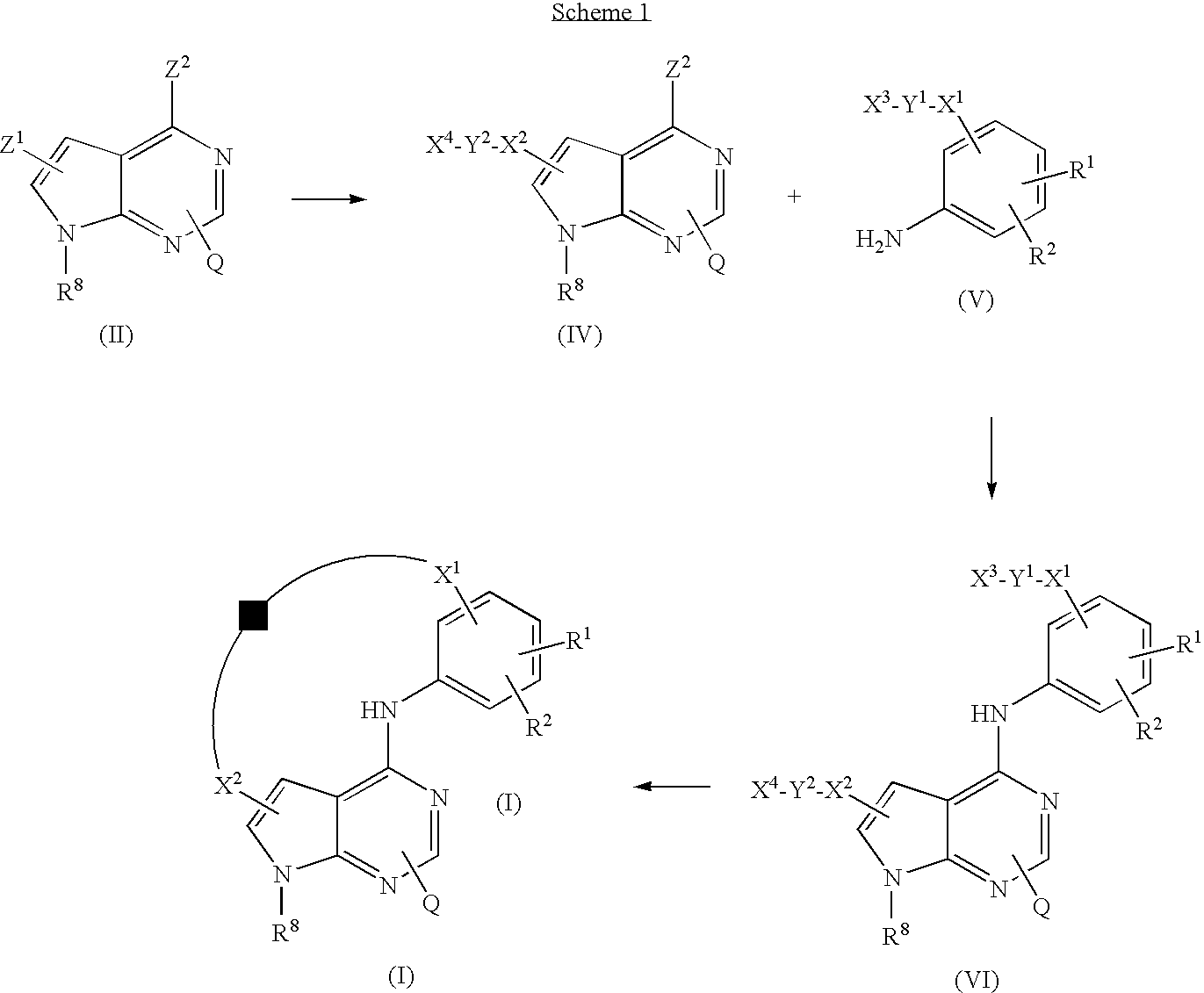Pyrrolopyrimidines
a technology of pyrrolopyrimidine and pyrrolopyrimidine, which is applied in the direction of biocide, cardiovascular disorder, drug composition, etc., can solve the problems of increasing the probability of mitotic errors, increasing the loss of checkpoint controls, and advancing benign lesions into malignant tumours
- Summary
- Abstract
- Description
- Claims
- Application Information
AI Technical Summary
Benefits of technology
Problems solved by technology
Method used
Image
Examples
example a1
[0330]a) Preparation of Intermediate 1
[0331]Reaction under N2 atmosphere. A mixture of 5-bromo-4-chloro-7H-pyrrolo[2,3-d]pyrimidine (0.010 mol) in THF (65 ml; dry) was stirred at −78° C. BuLi (0.022 mol; 2.5 M) was added dropwise at −78° C. Then the mixture was stirred for 30 minutes at −78° C. DMF (2 ml; dry) was added dropwise at −78° C. and the reaction mixture was stirred at r.t. for 1 hour. An aq. NH4Cl solution was added (decomposition). This mixture was extracted with EtOAc. The separated organic layer was dried, filtered and the solvent was evaporated. The residue (1.9 g) was stirred in DIPE, filtered off and dried. Yield: 1.420 g of intermediate 1.
[0332]b) Preparation of Intermediate 2
[0333]A mixture of N-(2-aminoethyl)-N-methylcarbamic acid 1,1-dimethylethyl ester (1.044 g, 0.0060 mol) and NaBH(OAc)3 (3.2 g, 0.015 mol) in DCM (50 ml) was stirred at r.t.. A solution of intermediate 1 (0.905 g, 0.0050 mol) in THF / DMF 1 / 1 (70 ml) was added dropwise. Stirring was continued for...
example a2
[0334]a) Preparation of Intermediate 3
[0335]A mixture of 2-methoxy-5-nitrophenol (0.001 mol), 4-chlorobutanoic acid methyl ester (0.0013 mol) and Cs2CO3 (1.63 g) in DMF (30 ml) was stirred at r.t.. When the reaction was finished, the solvent was evaporated. The residue was partitioned between H2O and toluene (3×). The organic layers were combined, dried (MgSO4), filtered and the solvent was evaporated. Yield: 0.250 g of intermediate 3.
[0336]b) Preparation of Intermediate 4
[0337]A mixture of intermediate 3 (0.0008 mol) in MeOH (40 ml) was hydrogenated with Pd / C 10% (1 g) as a catalyst in the presence of a thiophene solution (0.1 ml; 4% in DIPE). After uptake of H2 (3 eq.), the catalyst was filtered off and the filtrate was evaporated. Yield: 0.158 g of intermediate 4.
example a3
[0338]a) Preparation of Intermediate 5
[0339]3-Nitrophenol (5 g, 0.036 mol) was dissolved in DMA (70 ml). 5-Bromopentanoic acid methyl ester (7.7 g, 0.0395 mol) was added. K2CO3 (5.5 g, 0.0395 mol) was added to the stirred solution and the mixture was stirred overnigth at 60° C. After completion of the reaction (TLC monitoring), the mixture was partitioned between EtOAc and brine. The layers were separated and the organic layer dried (MgSO4), filtered and concentrated. The resulting product was dried under high vacuum. Yield: 9.3 g of intermediate 5 (used as such in next reaction step).
[0340]b) Preparation of Intermediate 6
[0341]Intermediate 5 (9.3 g., 0.036 mol) was dissolved in EtOH (175 ml). A thiophene solution (4 ml; 2% in DIPE) was added, followed by addition of Pd / C 10% as catalyst. After a N2 purge, H2 was introduced through a gas-bag. The reaction mixture was hydrogenated for 40 hours at r.t.. The catalyst was filtered off over a Celite-pad. HCl in dioxane (13 ml; 4 N) was a...
PUM
| Property | Measurement | Unit |
|---|---|---|
| temperature | aaaaa | aaaaa |
| temperature | aaaaa | aaaaa |
| flow rate | aaaaa | aaaaa |
Abstract
Description
Claims
Application Information
 Login to View More
Login to View More - R&D
- Intellectual Property
- Life Sciences
- Materials
- Tech Scout
- Unparalleled Data Quality
- Higher Quality Content
- 60% Fewer Hallucinations
Browse by: Latest US Patents, China's latest patents, Technical Efficacy Thesaurus, Application Domain, Technology Topic, Popular Technical Reports.
© 2025 PatSnap. All rights reserved.Legal|Privacy policy|Modern Slavery Act Transparency Statement|Sitemap|About US| Contact US: help@patsnap.com



